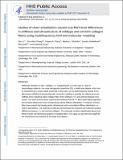Studies of chain substitution caused sub-fibril level differences in stiffness and ultrastructure of wildtype and oim/oim collagen fibers using multifrequency-AFM and molecular modeling
Author(s)
Li, Tao; Rodriguez-Florez, Naiara; Shefelbine, Sandra; Zeng, Kaiyang; Chang, Shu-Wei; Buehler, Markus J; Dao, Ming; ... Show more Show less
Downloadnihms812688.pdf (1.273Mb)
PUBLISHER_CC
Publisher with Creative Commons License
Creative Commons Attribution
Terms of use
Metadata
Show full item recordAbstract
Molecular alteration in type I collagen, i.e., substituting the α2 chain with α1 chain in tropocollagen molecule, can cause osteogenesis imperfecta (OI), a brittle bone disease, which can be represented by a mouse model (oim/oim). In this work, we use dual-frequency Atomic Force Microscopy (AFM) and incorporated with molecular modeling to quantify the ultrastructure and stiffness of the individual native collagen fibers from wildtype (+/+) and oim/oim diseased mice humeri. Our work presents direct experimental evidences that the +/+ fibers have highly organized and compact ultrastructure and corresponding ordered stiffness distribution. In contrast, oim/oim fibers have ordered but loosely packed ultrastructure with uncorrelated stiffness distribution, as well as local defects. The molecular model also demonstrates the structural and molecular packing differences between +/+ and oim/oim collagens. The molecular mutation significantly altered sub-fibril structure and mechanical property of collagen fibers. This study can give the new insight for the mechanisms and treatment of the brittle bone disease.
Date issued
2016-08Department
Massachusetts Institute of Technology. Department of Civil and Environmental Engineering; Massachusetts Institute of Technology. Department of Materials Science and EngineeringJournal
Biomaterials
Publisher
Elsevier BV
Citation
Li, Tao et al. “Studies of Chain Substitution Caused Sub-Fibril Level Differences in Stiffness and Ultrastructure of Wildtype and Oim/oim Collagen Fibers Using Multifrequency-AFM and Molecular Modeling.” Biomaterials 107 (November 2016): 15–22 © 2016 Elsevier Ltd
Version: Author's final manuscript
ISSN
0142-9612
1878-5905